
Château de Vendeuvre
Encyclopedia
The Château
de Vendeuvre (ʃɑto də vɑ̃dœvʁ) is situated in the commune
of Vendeuvre
, near to Lisieux
in Normandy
. Classed as a Historic Monument both for its exterior and interior, Vendeuvre is a prototypical aristocratic Norman country house. It was opened to the public in 1983.
and is a great example of a country house (maison de campagne) of the eighteenth century. Its owner, Alexandre Le Forestier, ‘'seigneur’' of Vendeuvre, coming from a Cotentin family that claimed descent from the Counts of Flanders, wanted a modern summer retreat built in the style of the day. The old manor-house was demolished, as it was damp (it was closer to the Dives
river-banks than the present building) and built partially into the hillside slope.
During the French Revolution
, Alexander of Vendeuvre and his family lived at Rouen
, their house at Caen
having been burned down. As the family didn’t emigrate during the Revolution, the chateau was saved from destruction, thus preserving the original décor and most of the furnishings.
The château is famous for its eighteenth-century interiors. Blondel paid particular attention to the highly sophisticated interior circulation and decoration. The facade is deliberately not ostentatious, as, according to Blondel, in his influential architectural thesis, ‘it is absolutely vital to avoid useless ornamentation and excessive facades that detract from the quality of what is inside’.
After the château was damaged during the Second World War, the present Count of Vendeuvre, a direct descendant of Alexander of Vendeuvre, set about the complete internal and exterior renovation of the chateau. The slate roof was re-laid in 1945. Following the completion of the interior renovation, the park’s restoration followed in 1970, using the original 1813 plans as a basis for the garden’s classic French style. In 1983 the Orangery was restored to its former state, having also been badly damaged as a result of action during the war.
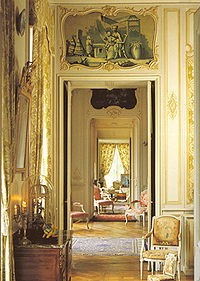 In the presentation of the château, each room presents a theme of eighteenth century daily life. Automaton
In the presentation of the château, each room presents a theme of eighteenth century daily life. Automaton
s (mannekins with recordings) point out the salient features of each room:
The chateau’s plan shows that it is twice as wide as it is deep, with a suite of state rooms distributed around a central hall supported by Ionic columns. The layout of the suites (each leads to the next) and the rounding of all the corners, help to spread the natural light throughout each room. The quality of the wood panelling in the main room is remarkable. The furniture is a comprehensive list of 18th century craftsmanship.
There are many curiosities too: a chandelier with real goldfish in a bowl, a travelling enema kit and a ‘'voyeuse’', a chair with a padded elbow-rest upon which elegant ladies would kneel or sit whilst playing indoor games, so as not to crumple the arrangement of their dresses over wide pannier
s.
 Copper and tin vessels of all shapes and sizes, with old earthenware and faience
Copper and tin vessels of all shapes and sizes, with old earthenware and faience
containers, give the impression that this beautifully arranged kitchen could still be used. Under the stone vaulted ceiling, in the huge fireplace, stands a mechanical rotisserie
, still in working order. In a corner of the fireplace there is an oven, which was used for broiling and pot-roasting. In the other corner of the fireplace, lumps of wood were permanently smoldering. These were transported, using large pans, to the oven opposite, or to one of the five smaller fireplaces situated in the wall opposite, where slow-cooked dishes, such as soups and sauces were prepared. Set into the wall of another corner is a smaller oven once used for pastry-baking. All the wood ash would have been collected and sifted for use in the household laundry.

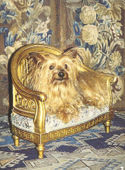 In a room next to the kitchen is a unique collection of pet-carriers, baskets and kennels. Small dogs and cats were the object of much care and attention, as testified by the refinement and variety of sumptuous places in which they lived, slept and travelled. Some were even provided with bedding matched to the full-sized furniture of the room in which they were placed, others were miniature versions of the furniture, but gilded. Some of the very ornate kennels had three compartments.
In a room next to the kitchen is a unique collection of pet-carriers, baskets and kennels. Small dogs and cats were the object of much care and attention, as testified by the refinement and variety of sumptuous places in which they lived, slept and travelled. Some were even provided with bedding matched to the full-sized furniture of the room in which they were placed, others were miniature versions of the furniture, but gilded. Some of the very ornate kennels had three compartments.
The cat’s bed, in the photograph opposite, is à la polonaise with a dais and drawn-up curtains, and was made for one of the daughters of Louis XV of France
for her pet. Louis XV himself had a King Charles Spaniel
called Filou (Rascal). Its bed was a cushion of crimson velvet and it wore a gold collar encrusted with diamonds. Louis XV said of his dog: “He’s the only thing in the world that likes me for myself”.
These small ‘pet-dwellings’ are extremely rare and unusual reminders of times past, when pets were often looked after better than the workers of the estate.

ed lime trees (linden
s), against a background of mature woodlands. Beyond the sloping fields of the valley of the river Dives
, the hills of the Pays d'Auge
can be seen in the far distance.
Restored according to plans, of 1813, these French geometric gardens perfectly complement the equally symmetrical garden front of the château.

s, to the side of the chateau, marks the area of the ‘practical’ or ‘utility’ gardens. An essential part of the château during the 18th – 20th centuries, providing much home-grown food, the so-called practical gardens include:
, mankind became fascinated by hydraulic mechanisms. They were particularly fashionable in France in the 17th and 18th centuries, to entertain, amaze and charm. To add a further dimension to their parks and gardens, artificial devices to imitate nature have found their place, most notably in the form of fountains.
 Linked to a legend from antiquity, of a tree that drew, by its roots, all science and wisdom. Around it, plants were cultivated and fertilized by the spirits of the place. This celestial tree offered, to those that it chose, a dew that transmitted wisdom and eternity. Since earliest times, trees have been the object of worship, perhaps because their roots attain the underground depths and their branches symbolize the aspiration of ascension towards the sky.
Linked to a legend from antiquity, of a tree that drew, by its roots, all science and wisdom. Around it, plants were cultivated and fertilized by the spirits of the place. This celestial tree offered, to those that it chose, a dew that transmitted wisdom and eternity. Since earliest times, trees have been the object of worship, perhaps because their roots attain the underground depths and their branches symbolize the aspiration of ascension towards the sky.
fountain, created when Pegasus
had kicked the ground with his hooves. Whoever drank of the water was sure to be inspired by the Muses. Once asleep, the gardener dreamt of four men: a gardening technician, a man of good taste, a poet and a painter. They said to him that they, individually, were incapable of creating a great garden, but that together they had built the most beautiful gardens of the world. On his awakening, the gardener tried the fountain’s water whilst praying that the Muses would grant him the four gifts necessary to his profession: technique, good taste, poetry and art. Laughing, they instead gave him green fingers.
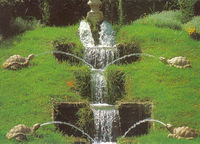 The tortoise
The tortoise
plays an important role in the mythology of many cultures. In Central America
, according to an ancient legend, the rain god Chaac
had fallen under the charms of a beautiful goddess and forsaken the land. A severe drought reigned throughout the country of the Mayas
but Chaac
no longer heard the invocations of the priests. As a last recourse, the Mayas asked the sacred tortoises to intervene with the rain god. Hoisted on the roof of the temples and houses, the tortoises called out his name “Chaac” as one voice, which brought him to his senses. At his invitation, the tortoises spat water, quenching the thirst of the Mayans and saving the harvests.
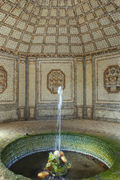 Neptune
Neptune
, Greek god of the sea, was enticed by the beautiful and wise nymph, Cléance. One day, he threw himself upon her, but Cléance defended herself so well that Neptune backed off. "The coldness of rock will suit you", he said, transforming her immediately into stone. Shocked by this, the other nymphs implored Thetis
to intercede with the gods on Olympus
for the restoration of her life. Not being able to do anything against the power of Neptune, they agreed on a compromise: Cléance would remain a stone statue but inside, her heart could carry on beating.
, took refuge in the cave, taking on the form of a fountain of pure water.
This grotto is inspired by that mythological cave. The 200,000 shells used on the walls at Vendeuvre help to recreate the supernatural atmosphere that suits a dwelling of the nymphs.
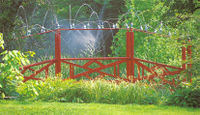 Chinese legend has it that a very beautiful girl named Yin never tired of looking at her own reflection in the water whenever she took a walk across the red bridge. Han, the bird-catcher, opened his heart to her, but Yin rejected it, because the water only showed the reflection of his graceless face. Moved by the sadness of the bird-catcher, the doves began to spit in the water, which immediately reflected the souls of the two young people. Yin’s reflection became distorted by her vanity whilst Han’s reflection illuminated the surface. This vision melted the heart of Yin and the couple loved each other so much that, on certain evenings, one can make out their silhouettes leaning on the scarlet bridge.
Chinese legend has it that a very beautiful girl named Yin never tired of looking at her own reflection in the water whenever she took a walk across the red bridge. Han, the bird-catcher, opened his heart to her, but Yin rejected it, because the water only showed the reflection of his graceless face. Moved by the sadness of the bird-catcher, the doves began to spit in the water, which immediately reflected the souls of the two young people. Yin’s reflection became distorted by her vanity whilst Han’s reflection illuminated the surface. This vision melted the heart of Yin and the couple loved each other so much that, on certain evenings, one can make out their silhouettes leaning on the scarlet bridge.
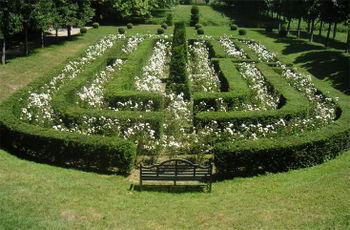 Labyrinth
Labyrinth
s were places of escape. It was said that whenever anyone had worries, a walk in the mysterious labyrinth helped one escape the real world if only for a short time.
The gardens of the château of Vendeuvre contain two mazes, known as the 'regular maze' and the 'field maze'
Château
A château is a manor house or residence of the lord of the manor or a country house of nobility or gentry, with or without fortifications, originally—and still most frequently—in French-speaking regions...
de Vendeuvre (ʃɑto də vɑ̃dœvʁ) is situated in the commune
Communes of France
The commune is the lowest level of administrative division in the French Republic. French communes are roughly equivalent to incorporated municipalities or villages in the United States or Gemeinden in Germany...
of Vendeuvre
Vendeuvre
-Sites of interest:*Château de Vendeuvre and its gardens with labyrinth, cascades, kiosk, temple, cave with shells.-References:*...
, near to Lisieux
Lisieux
Lisieux is a commune in the Calvados department in the Basse-Normandie region in northwestern France.Lisieux is the capital of the Pays d'Auge area, which is characterised by valleys and hedged farmland...
in Normandy
Normandy
Normandy is a geographical region corresponding to the former Duchy of Normandy. It is in France.The continental territory covers 30,627 km² and forms the preponderant part of Normandy and roughly 5% of the territory of France. It is divided for administrative purposes into two régions:...
. Classed as a Historic Monument both for its exterior and interior, Vendeuvre is a prototypical aristocratic Norman country house. It was opened to the public in 1983.
For the visitor to see
- State rooms giving a taste of daily life in the 18th century.
- The extensive museum of miniature furniture.
- 18th-century kitchens.
- A collection of furniture and bedding for pampered pets.
- Formal, utility and water gardens.
- A shell-lined grottoGrottoA grotto is any type of natural or artificial cave that is associated with modern, historic or prehistoric use by humans. When it is not an artificial garden feature, a grotto is often a small cave near water and often flooded or liable to flood at high tide...
. - PavilionPavilion (structure)In architecture a pavilion has two main meanings.-Free-standing structure:Pavilion may refer to a free-standing structure sited a short distance from a main residence, whose architecture makes it an object of pleasure. Large or small, there is usually a connection with relaxation and pleasure in...
s and folliesFollyIn architecture, a folly is a building constructed primarily for decoration, but either suggesting by its appearance some other purpose, or merely so extravagant that it transcends the normal range of garden ornaments or other class of building to which it belongs...
History
Vendeuvre was built between 1750 and 1752 from the plans of architect Jacques-François BlondelJacques-François Blondel
Jacques-François Blondel was a French architect. He was the grandson of François Blondel , whose course of architecture had appeared in four volumes in 1683 -Biography:...
and is a great example of a country house (maison de campagne) of the eighteenth century. Its owner, Alexandre Le Forestier, ‘'seigneur’' of Vendeuvre, coming from a Cotentin family that claimed descent from the Counts of Flanders, wanted a modern summer retreat built in the style of the day. The old manor-house was demolished, as it was damp (it was closer to the Dives
Dives River
The Dives is a 105 km long river in the Pays d'Auge, Normandie, France. It flows into the English Channel in Cabourg.The source of the Dives is near Exmes, in the Orne department...
river-banks than the present building) and built partially into the hillside slope.
During the French Revolution
French Revolution
The French Revolution , sometimes distinguished as the 'Great French Revolution' , was a period of radical social and political upheaval in France and Europe. The absolute monarchy that had ruled France for centuries collapsed in three years...
, Alexander of Vendeuvre and his family lived at Rouen
Rouen
Rouen , in northern France on the River Seine, is the capital of the Haute-Normandie region and the historic capital city of Normandy. Once one of the largest and most prosperous cities of medieval Europe , it was the seat of the Exchequer of Normandy in the Middle Ages...
, their house at Caen
Caen
Caen is a commune in northwestern France. It is the prefecture of the Calvados department and the capital of the Basse-Normandie region. It is located inland from the English Channel....
having been burned down. As the family didn’t emigrate during the Revolution, the chateau was saved from destruction, thus preserving the original décor and most of the furnishings.
The château is famous for its eighteenth-century interiors. Blondel paid particular attention to the highly sophisticated interior circulation and decoration. The facade is deliberately not ostentatious, as, according to Blondel, in his influential architectural thesis, ‘it is absolutely vital to avoid useless ornamentation and excessive facades that detract from the quality of what is inside’.
After the château was damaged during the Second World War, the present Count of Vendeuvre, a direct descendant of Alexander of Vendeuvre, set about the complete internal and exterior renovation of the chateau. The slate roof was re-laid in 1945. Following the completion of the interior renovation, the park’s restoration followed in 1970, using the original 1813 plans as a basis for the garden’s classic French style. In 1983 the Orangery was restored to its former state, having also been badly damaged as a result of action during the war.
Interior

Automaton
An automaton is a self-operating machine. The word is sometimes used to describe a robot, more specifically an autonomous robot. An alternative spelling, now obsolete, is automation.-Etymology:...
s (mannekins with recordings) point out the salient features of each room:
- The dining room demonstrates the art of receiving and entertaining guests.
- The state bedroom, with many wardrobes, is devoted to dressing and make-up. The automaton represents a lady of the time, enjoying the pleasures of washing and dressing in her boudoirBoudoirA boudoir is a lady's private bedroom, sitting room or dressing room. The term derives from the French verb bouder, meaning "to be sulky" or boudeur, meaning "sulky".- In architecture :...
. - The office exhibits paraphernalia associated with writing. .
- The small parlour displays family portraits.
- The Grand Salon shows the pleasures of indoor games.
The chateau’s plan shows that it is twice as wide as it is deep, with a suite of state rooms distributed around a central hall supported by Ionic columns. The layout of the suites (each leads to the next) and the rounding of all the corners, help to spread the natural light throughout each room. The quality of the wood panelling in the main room is remarkable. The furniture is a comprehensive list of 18th century craftsmanship.
There are many curiosities too: a chandelier with real goldfish in a bowl, a travelling enema kit and a ‘'voyeuse’', a chair with a padded elbow-rest upon which elegant ladies would kneel or sit whilst playing indoor games, so as not to crumple the arrangement of their dresses over wide pannier
Pannier
A pannier is a basket, bag, box, or similar container, carried in pairs either slung over the back of a beast of burden, or attached to the sides of a bicycle or motorcycle. The term derives from the Old French, from Classical Latin, word for bread basket....
s.
The Kitchen

Faience
Faience or faïence is the conventional name in English for fine tin-glazed pottery on a delicate pale buff earthenware body, originally associated with Faenza in northern Italy. The invention of a white pottery glaze suitable for painted decoration, by the addition of an oxide of tin to the slip...
containers, give the impression that this beautifully arranged kitchen could still be used. Under the stone vaulted ceiling, in the huge fireplace, stands a mechanical rotisserie
Rotisserie
Rotisserie is a style of roasting where meat is skewered on a spit - a long solid rod used to hold food while it is being cooked over a fire in a fireplace or over a campfire, or roasted in an oven. This method is generally used for cooking large joints of meat or entire animals, such as pigs,...
, still in working order. In a corner of the fireplace there is an oven, which was used for broiling and pot-roasting. In the other corner of the fireplace, lumps of wood were permanently smoldering. These were transported, using large pans, to the oven opposite, or to one of the five smaller fireplaces situated in the wall opposite, where slow-cooked dishes, such as soups and sauces were prepared. Set into the wall of another corner is a smaller oven once used for pastry-baking. All the wood ash would have been collected and sifted for use in the household laundry.
Pet pampering


The cat’s bed, in the photograph opposite, is à la polonaise with a dais and drawn-up curtains, and was made for one of the daughters of Louis XV of France
Louis XV of France
Louis XV was a Bourbon monarch who ruled as King of France and of Navarre from 1 September 1715 until his death. He succeeded his great-grandfather at the age of five, his first cousin Philippe II, Duke of Orléans, served as Regent of the kingdom until Louis's majority in 1723...
for her pet. Louis XV himself had a King Charles Spaniel
King Charles Spaniel
The King Charles Spaniel is a small dog breed of the spaniel type. In 1903, the Kennel Club combined four separate toy spaniel breeds under this single title...
called Filou (Rascal). Its bed was a cushion of crimson velvet and it wore a gold collar encrusted with diamonds. Louis XV said of his dog: “He’s the only thing in the world that likes me for myself”.
These small ‘pet-dwellings’ are extremely rare and unusual reminders of times past, when pets were often looked after better than the workers of the estate.

Formal Gardens
The formal gardens that have been created by the present Count of Vendeuvre, have a strictly symmetrical classical lay-out of closely clipped scrolling designs set against gravel reserves, and borders and box hedges set in lawns, with a formal water beyond, flanked by pollardPollard
Pollard may refer to:*Pollard , a list of people named "Pollard"*Pollard, Alabama, a town in the United States*Pollard, a novel by Laura Beatty*Pollard, a tree or animal which has been polled :...
ed lime trees (linden
Tilia
Tilia is a genus of about 30 species of trees native throughout most of the temperate Northern Hemisphere. The greatest species diversity is found in Asia, and the genus also occurs in Europe and eastern North America, but not western North America...
s), against a background of mature woodlands. Beyond the sloping fields of the valley of the river Dives
Dives River
The Dives is a 105 km long river in the Pays d'Auge, Normandie, France. It flows into the English Channel in Cabourg.The source of the Dives is near Exmes, in the Orne department...
, the hills of the Pays d'Auge
Pays d'Auge
The Pays d'Auge is an area in Normandy, straddling the départements of Calvados and Orne . The chief town is Lisieux.-Geography:Generally it consists of the basin of the Touques River....
can be seen in the far distance.
Restored according to plans, of 1813, these French geometric gardens perfectly complement the equally symmetrical garden front of the château.

'Utility gardens
An avenue of 150-year-old limes or lindenTilia
Tilia is a genus of about 30 species of trees native throughout most of the temperate Northern Hemisphere. The greatest species diversity is found in Asia, and the genus also occurs in Europe and eastern North America, but not western North America...
s, to the side of the chateau, marks the area of the ‘practical’ or ‘utility’ gardens. An essential part of the château during the 18th – 20th centuries, providing much home-grown food, the so-called practical gardens include:
- A fish pond containing, at one end, troutTroutTrout is the name for a number of species of freshwater and saltwater fish belonging to the Salmoninae subfamily of the family Salmonidae. Salmon belong to the same family as trout. Most salmon species spend almost all their lives in salt water...
for special occasions and at the other end, separated by netting, the more common freshwater fish for Fridays and other fasting days. The fish would have been fed from kitchen scraps and pellets of flour. - A dovecoteDovecoteA dovecote or dovecot is a structure intended to house pigeons or doves. Dovecotes may be square or circular free-standing structures or built into the end of a house or barn. They generally contain pigeonholes for the birds to nest. Pigeons and doves were an important food source historically in...
, rebuilt in 1811, which has over 1400 doveDovePigeons and doves constitute the bird family Columbidae within the order Columbiformes, which include some 300 species of near passerines. In general terms "dove" and "pigeon" are used somewhat interchangeably...
holes. The roof was designed to catch some rainwater for the birds to bathe in. - An Ice House built as a pyramidPyramidA pyramid is a structure whose outer surfaces are triangular and converge at a single point. The base of a pyramid can be trilateral, quadrilateral, or any polygon shape, meaning that a pyramid has at least three triangular surfaces...
, to store the ice from the pond in the winter maze. It has a north-facing door to better help preserve the low temperature within.
The 'Surprise' water gardens
During the RenaissanceRenaissance
The Renaissance was a cultural movement that spanned roughly the 14th to the 17th century, beginning in Italy in the Late Middle Ages and later spreading to the rest of Europe. The term is also used more loosely to refer to the historical era, but since the changes of the Renaissance were not...
, mankind became fascinated by hydraulic mechanisms. They were particularly fashionable in France in the 17th and 18th centuries, to entertain, amaze and charm. To add a further dimension to their parks and gardens, artificial devices to imitate nature have found their place, most notably in the form of fountains.
The Crystal Tree

The fountain of the Muses
Inspired by another legend, this time of a young gardener discouraged by the failure of his garden, who went looking for help from the HippocreneHippocrene
In Greek mythology, Hippocrene was the name of a fountain on Mt. Helicon. It was sacred to the Muses and was formed by the hooves of Pegasus...
fountain, created when Pegasus
Pegasus
Pegasus is one of the best known fantastical as well as mythological creatures in Greek mythology. He is a winged divine horse, usually white in color. He was sired by Poseidon, in his role as horse-god, and foaled by the Gorgon Medusa. He was the brother of Chrysaor, born at a single birthing...
had kicked the ground with his hooves. Whoever drank of the water was sure to be inspired by the Muses. Once asleep, the gardener dreamt of four men: a gardening technician, a man of good taste, a poet and a painter. They said to him that they, individually, were incapable of creating a great garden, but that together they had built the most beautiful gardens of the world. On his awakening, the gardener tried the fountain’s water whilst praying that the Muses would grant him the four gifts necessary to his profession: technique, good taste, poetry and art. Laughing, they instead gave him green fingers.
The tortoise cascade

Tortoise
Tortoises are a family of land-dwelling reptiles of the order of turtles . Like their marine cousins, the sea turtles, tortoises are shielded from predators by a shell. The top part of the shell is the carapace, the underside is the plastron, and the two are connected by the bridge. The tortoise...
plays an important role in the mythology of many cultures. In Central America
Central America
Central America is the central geographic region of the Americas. It is the southernmost, isthmian portion of the North American continent, which connects with South America on the southeast. When considered part of the unified continental model, it is considered a subcontinent...
, according to an ancient legend, the rain god Chaac
Chaac
Chaac is the name of the Maya rain deity. With his lightning axe, Chaac strikes the clouds and produces thunder and rain. Chaac corresponds to Tlaloc among the Aztecs.-Rain deities and rain makers:...
had fallen under the charms of a beautiful goddess and forsaken the land. A severe drought reigned throughout the country of the Mayas
Maya civilization
The Maya is a Mesoamerican civilization, noted for the only known fully developed written language of the pre-Columbian Americas, as well as for its art, architecture, and mathematical and astronomical systems. Initially established during the Pre-Classic period The Maya is a Mesoamerican...
but Chaac
Chaac
Chaac is the name of the Maya rain deity. With his lightning axe, Chaac strikes the clouds and produces thunder and rain. Chaac corresponds to Tlaloc among the Aztecs.-Rain deities and rain makers:...
no longer heard the invocations of the priests. As a last recourse, the Mayas asked the sacred tortoises to intervene with the rain god. Hoisted on the roof of the temples and houses, the tortoises called out his name “Chaac” as one voice, which brought him to his senses. At his invitation, the tortoises spat water, quenching the thirst of the Mayans and saving the harvests.
The water nymph’s grotto

Neptune
Neptune is the eighth and farthest planet from the Sun in the Solar System. Named for the Roman god of the sea, it is the fourth-largest planet by diameter and the third largest by mass. Neptune is 17 times the mass of Earth and is slightly more massive than its near-twin Uranus, which is 15 times...
, Greek god of the sea, was enticed by the beautiful and wise nymph, Cléance. One day, he threw himself upon her, but Cléance defended herself so well that Neptune backed off. "The coldness of rock will suit you", he said, transforming her immediately into stone. Shocked by this, the other nymphs implored Thetis
Thetis
Silver-footed Thetis , disposer or "placer" , is encountered in Greek mythology mostly as a sea nymph or known as the goddess of water, one of the fifty Nereids, daughters of the ancient one of the seas with shape-shifting abilities who survives in the historical vestiges of most later Greek myths...
to intercede with the gods on Olympus
Mount Olympus
Mount Olympus is the highest mountain in Greece, located on the border between Thessaly and Macedonia, about 100 kilometres away from Thessaloniki, Greece's second largest city. Mount Olympus has 52 peaks. The highest peak Mytikas, meaning "nose", rises to 2,917 metres...
for the restoration of her life. Not being able to do anything against the power of Neptune, they agreed on a compromise: Cléance would remain a stone statue but inside, her heart could carry on beating.
The Shell Grotto
Under an exotic copper-roofed pavilion is a "cool room" where one can rest during hot summer days. According to Greco-Roman mythology, a young nymph, followed by the god PanPan (mythology)
Pan , in Greek religion and mythology, is the god of the wild, shepherds and flocks, nature, of mountain wilds, hunting and rustic music, as well as the companion of the nymphs. His name originates within the Greek language, from the word paein , meaning "to pasture." He has the hindquarters, legs,...
, took refuge in the cave, taking on the form of a fountain of pure water.
This grotto is inspired by that mythological cave. The 200,000 shells used on the walls at Vendeuvre help to recreate the supernatural atmosphere that suits a dwelling of the nymphs.
The Temple of Serenity
Evocative of the story of a powerful king in a rich country where the inhabitants were very happy. The King, always a worrier, was continually dissatisfied with his position and with that of his kingdom. He went to consult the Wise Woman of the Lost Wood that prescribed meditation at the ‘temple of the eight columns’. The king entered the temple but after only a few minutes all his problems had returned. He was going to leave when it began to rain all around the temple, preventing him from leaving. Little by little, the light music of the raindrops on the ground helped lighten his anguish. Passing through the veil of rain, all at last seemed well with the world. On the ground in front of each column of the temple was a single letter, carved out by the rainwater. The letters spelt the word “SERENITY”The Chinese bridge

The Mazes

Labyrinth
In Greek mythology, the Labyrinth was an elaborate structure designed and built by the legendary artificer Daedalus for King Minos of Crete at Knossos...
s were places of escape. It was said that whenever anyone had worries, a walk in the mysterious labyrinth helped one escape the real world if only for a short time.
The gardens of the château of Vendeuvre contain two mazes, known as the 'regular maze' and the 'field maze'
- The regular labyrinth is a mass of yew hedging and white rose bushes in the lawn.
- The field labyrinth covers a surface of one hectare. A green paradise of rare trees and many wonders, towards the Japanese tea pavilion. Here, all visitors are encouraged to take part in the hunt for a small rabbit.

